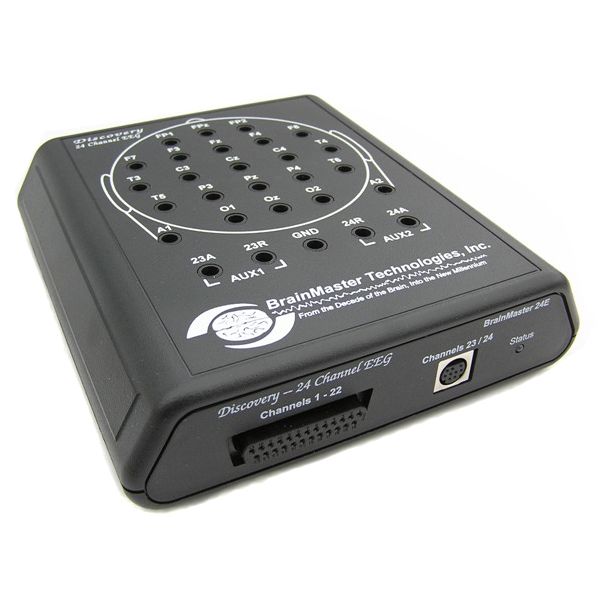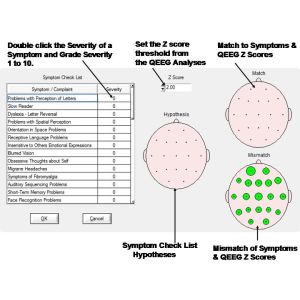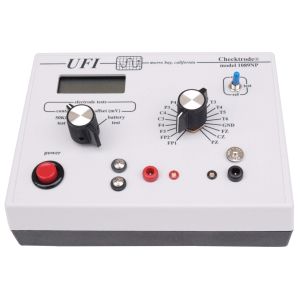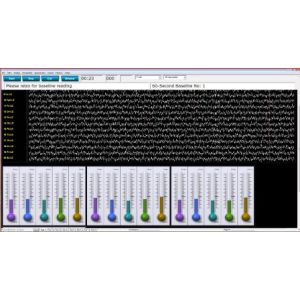The Brainmaster Discovery 24E is a 24-channel EEG and DC amplifier that is an evolution of the technology used in the 2E and 2EA (Atlantis) series of EEG biofeedback devices.
The Brainmaster Discovery 24E is fully compatible with QEEG software such as NeuroGuide, Loreta,SKIL, WinEEG and BrainDx , and incorporates BrainMaster training capabilities including amplitude and connectivity training and an option for NeuroGuide, Loreta,Live Z-Score training.
The Discovery 24E is a very easy to use 24 Channel EEG acquisition unit. With the NeuroGuide.
Special return conditions apply to this custom item. See our Return Policy and Condition of Sale for details.
USB powered qEEG equipment.
Discovery 24E Sensor and Offset Information
The Discovery amplifiers are designed to provide EEG signals from DC (0 Hz) to 80 Hz, with 24-bit accuracy. Because the amplifiers are DC sensitive, we are able to measure the offset potential (voltage) on each sensor, which includes the standing voltage across the sensor/skin boundary. As such, the DC sensor offset is a useful means of assessing sensor connection quality. When sensor connection is poor, the offset will be high (greater than 100 millivolts), and it decreases as the sensors are gelled and abraded. In our experience, as you "bring in" the sensor connections on the electro-cap, the sensor offsets go down to the 50 millivolt range, and only as the sensor is properly abraded, the offset goes down to below 25 millivolts (tin or gold sensors). With silver chloride sensors, offsets below 5 millivolts should be achieved.
The Discovery does not monitor sensor impedance as the Atlantis does. Instead, it monitors the DC offset potential on all 24 channels, and uses them to assess sensor connection quality. While there does not seem to be an exact correspondence between sensor offset and sensor impedance, we have found that when sensor offsets below 25 millivolts are achieved, then good recordings can be expected. Some field testers have seen conditions in which low sensor offsets are found even when sensor impedance is 30K or more, but that good recordings can still be made. Using sensor offset to assess connection quality has also been found satisfactory in at least one other system (Nexus by Mind Media).
For users who specifically want to monitor sensor impedance, it is necessary to do that as a separate step, using an external meter. A suitable device is the CheckTrode made by UFI and is part number 1089NP. We recommend and may supply this device in the future.
In clinical testing, we have found that gold, tin, or silver/silver chloride sensors can be used. We make the following recommendations:
Gold sensors provide the best ability to record with acceptable DC stability, and moderate high-frequency response. They are recommended for general use. When using them, you can look for sensor offsets generally below 50 millivolts, to ensure connection quality.
Tin sensors provide suitable recordings for assessment, but may show excessive DC instability during recording. The DC information is generally removed by the filters when postprocessing with NeuroGuide , but may be disconcerting to see in the acquired data. Offsets below 30 millivolts can be seen with good connections.
Silver / Silver Chloride (Ag/AgCl ) sensors provide best DC stability and low offsets, but also have more high-frequency response and noise, which may be disconcerting during recording. The high frequencies are filtered out during analysis, so that the signals appear to be less fuzzy when reviewed. Offsets below 10 millivolts can be seen with good connections.
All three types of sensors provide acceptable recordings for purposes of analysis.
The observed offset values on the acquisition screen in BrainMaster software is generally useful for assessing sensor connection quality. When initially gelled but not abraded, electro-caps produce offset values generally well in excess of 100 millivolts, and may be over 1000 millivolts. By ensuring all offset values are below a threshold value (about 50 millivolts for gold, 30 millivolts for tin, and 10 millivolts for Silver / Silver Chloride), suitable connections should be achievable. In addition, the input impedance (1000 GOhms) of the Discovery amplifiers ensures that valid recordings can be made well above the traditionally required sensor impedance values.
DC and slow EEG information can include skin potentials and changes, non-neuronal sources such as epithelial cells, CSF interfaces, artery interfaces and glial cells, and the Ag/Cl is a salt that dissolves and has small fractures and imperfections on the surface, thus giving rise to high frequency noise. (per R. Thatcher). So when using Ag/AgCl sensors, you are recording a lot of additional physiological information that is masked out by gold or tin sensors.
System Requirements
The minimum recommended PC requirements to operate the Discovery 24E are:
(DRAFT, subject to change)
-
Windows XP recommended. We have seen problems with Vista keeping up with the data flow.
- 2 GHz Intel dual core processor
- 2-4 GBytes RAM memory (more required for Vista)
- 256 Mbyte video RAM
- 1280 x 1024 main video display
The Discovery 24 is a 24-channel EEG device that provides 256 samples/second of 24-bit resolution EEG and DC brain potentials.
It incorporates an optically and magnetically isolated USB interface operating at 480600 baud.
The data speed requirement is approximately 19200 bytes per second, continuous. The PC must be able to keep up with this requirement.
Specifications
- 24 channels
- Electrode cap: Standard "Lexicor" or equivalent, with Fpz and Oz optionally added
- Channels 1 - 22 referenced to A1
- A2 acquired separately, referenced to A1
- Channels 23, 24 separate differential amplifiers with separate active and reference inputs
- Channels 23, 24 connectors: "Atlantis" 2-channel connector with cable & standard touch-proof leads
- A/D accuracy: 24 bits; resolution 0.01 microvolts EEG, 0.4 microvolts DC
- Input range: +/- 100 millivolts EEG, +/- 4 volts DC
- Input impedance > 1000GOhms
- Common-mode Rejection Ratio (CMRR ) > 110 dB
- Amplifier bandwidth: 0.000 - 100 Hz
- EEG channel bandwidth: 0.43 - 80 Hz
- DC offset signal bandwidth: 0.000 - 2 Hz
- Input noise < 1.0 microvolt RMS (0.43 - 60 Hz)
- Sensor contact quality monitored via. offset voltage
- Sampling Rate: 512 samples/second
- Data rate to PC: 256 samples/second
- Connection to PC: USB, optically and magnetically isolated
- Software Supported (Live Acquisition) BrainMaster Discovery, NeuroGuide Live
- Software Supported (Analysis via EDF Files): NeuroGuide, SKIL, WinEEG, Persyst, EDFBrowser, other



![3-Dimensional LORETA Z Score Neurofeedback for Neuroguide - [NF2]](https://cdn.bio-medical.com/media/catalog/product/cache/1fb5323e87cc519c65f88e57c730a303/3/d/3d_loreta_zscore.jpg)




![NeuroGuide Deluxe QEEG - [NG]](https://cdn.bio-medical.com/media/catalog/product/cache/1fb5323e87cc519c65f88e57c730a303/l/o/logo-neuroguide.png)

